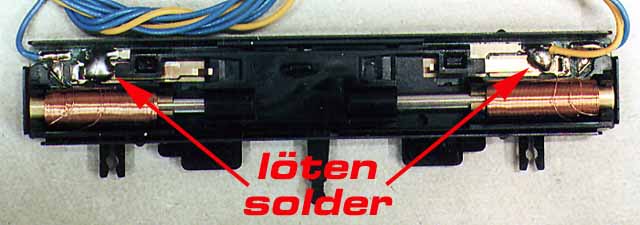
In order to build an optically appealing model railway, it is essential to hide the turnout and signal actuators as much as possible. While it is quite simple with signals, it often causes problems with turnouts. Maerklin offers for the turnout actuators a so-called under the baseboard installation kit 7548 to 7549, but in practice this contraption shines repeatedly by malfunctioning. This is annoying especially with automatic operation, as reliable turnout operation must be ensured.

Eine der Fehlerquellen ist die Stromendabschaltung der Spulen. Im Laufe der Zeit verzundern die Kontakte. Dann schalten die Weichen nur noch manchmal und später garnicht mehr. Arbeitet der Antrieb "über Kopf", gibt es meist schon nach sehr kurzer Zeit Kontaktprobleme. Abhilfe schaffen zwei Lötpunkte wie im Bild ersichtlich. Damit ist die Endabschaltung überbrückt und der Antrieb schaltet viel kraftvoller. Da die Federkontakte erhalten bleiben, ist diese Modifikation reversibel.
One of the sources for malfunctioning is the current shutoff mechanism of the solenoids. In the course of time the contacts wear. Initially the actuator only fails sometimes and eventually it will seize to work altogether. If the actuating unit is installed upside down you can expect operating problems after a very short time. An easy remedy is to use two solder tacks as indicated in the picture. This will bridge the current cutoff mechanism and the actual switching of the actuator is more powerful. The spring-loaded contacts are preserved and thus this modification is reversible.
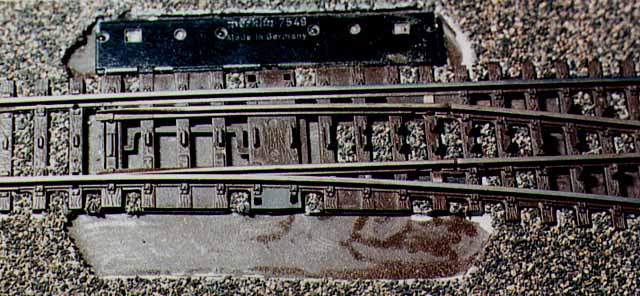
Wie schon erwähnt ist der Unterflurantrieb nicht nur unzuverlässig, auch ist der Montageaufwand enorm. Viel einfacher ist es die Antrieb umgedreht anzustecken, d.h. der Handstellhebel zeigt nach unten. Das Bild zeigt diesen in Verbindung einer Merkur Schotterbettung. Damit der schotterfreie Teil optisch weniger auffällig ist, habe ich ihn dunkelbraun angemalt. Schienen und Schwellen habe ich im selben Farbton sprühlackiert, um allem ein "rostiges" Aussehen zu verleihen. Die ungenutzte Antriebsaussparung und die Rückseite des Antriebes werden später mit Schotter beklebt.
As already mentioned the under baseboard mounting kit is not only unreliable, but also quite cumbersome to install. It is much simpler to connect the 7548 actuator to the turnout “upside-down”, i.e. the manual switch lever is pointing downward. The picture illustrates this in combination with the Merkur track bed. In order for the ballast-free section to be less noticeable, I paint the actuator in a dark-brown color. The tracks and railway ties were spray painted in the same color tone in order to lend everything a "rusty " appearance. The unused portion of the Merkur track bed recess and the rear side of the actuator are pasted later with ballast.
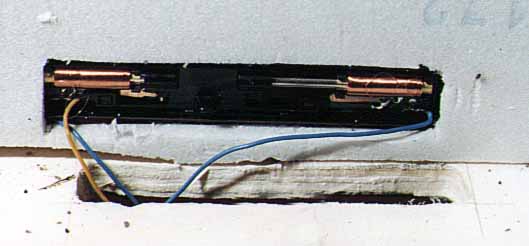
Damit der Antrieb oben nicht über den Schotter herrausragt, ist die Abdeckung zu entfernen. Soll der Antrieb im Notfall von unten auch manuell bedienbar sein, muß ein entsprechendes Loch in die Grundplatte gesägt werden. Wem das zu viel Arbeit ist, kann mit einem Seitenschneider den Handhebel des Antriebes abkneifen, weil dieser sonst auf der Platte schleift.
In order for the actuator not to wiggle its way out above the track bed, the cover must be removed. If the turnout is also to be manually operated in an emergency from below the baseboard, an appropriate size hole must be drilled into the baseboard. If a hole is not desirable, the hand lever of the actuator should be cut off, as it would scrape against the baseboard.
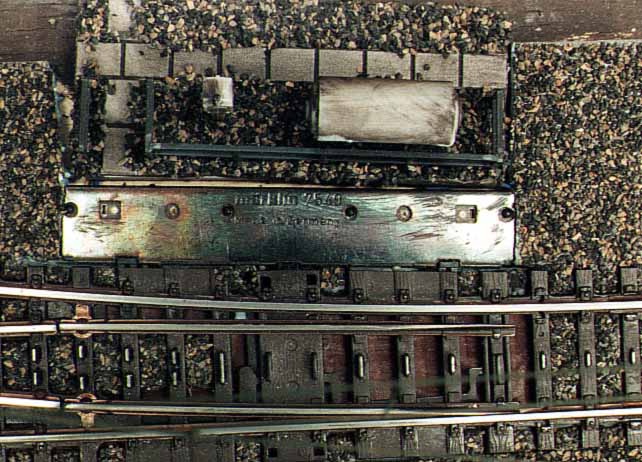
Im Bahnhofsbereich sind alle Gleise ebenerdig eingeschottert, d.h. es gibt keine Böschung. Die Antriebe sind also praktisch unsichtbar. Anders verhält es sich bei Weichen auf freier Strecke. Hier fällt es unangenehm auf, wenn die Böschung bei einer Weiche ohne Grund breiter wird. Diesen Grund kann man aber liefern, indem man eine Weichenheizung aufstellt, wie Faller sie im Programm hat. Dann "darf" das Schotterbett an dieser Stelle breiter sein.
In the station area all tracks are filled with ballast at track level, i.e. there are no embankments. Here the actuators are practically invisible. It looks differently for turnouts that are installed in the open tracksections, outside of stations. Here it is unpleasantly noticeable, if the embankment becomes broader at a turnout without reason. One can supply a reason however, by installing a turnout heating kit, as it is available from Faller. Then the ballast bed is allowed to be broader.
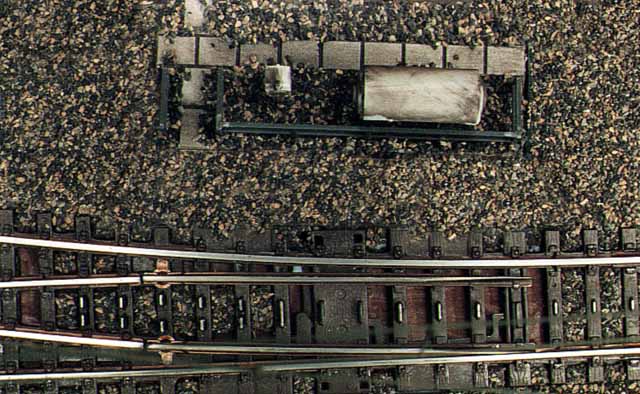
Nachdem der Antrieb mit Schotter beklebt ist, wirkt alles sehr realistisch. Zur optischen Aufwertung kann man zusätzlich eine Weichenantriebsatrappe von Erbert oder Völkner plazieren.
After the actuator has been pasted with ballast, everything looks very realistically. To further optically enhance the final look, one can additionally install a real-life actuator imitation from Erbert or Voelkner.